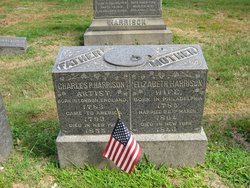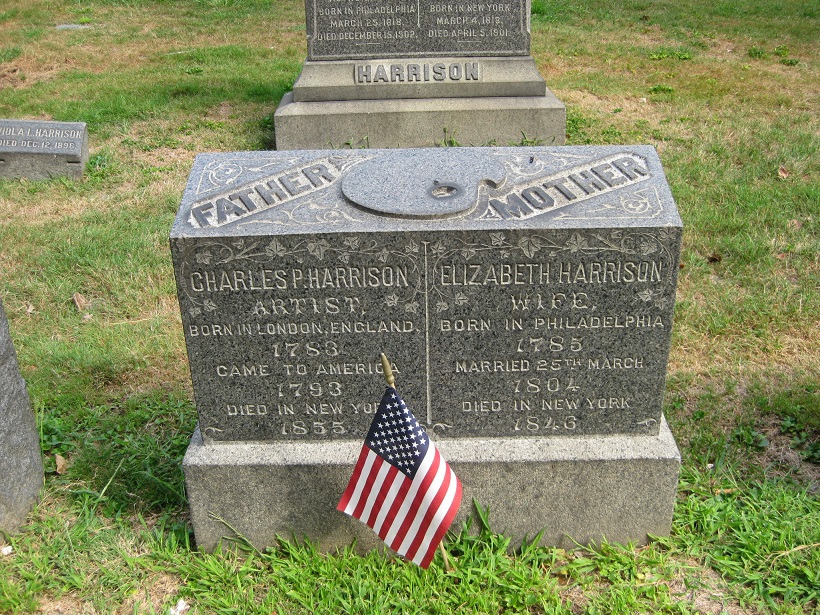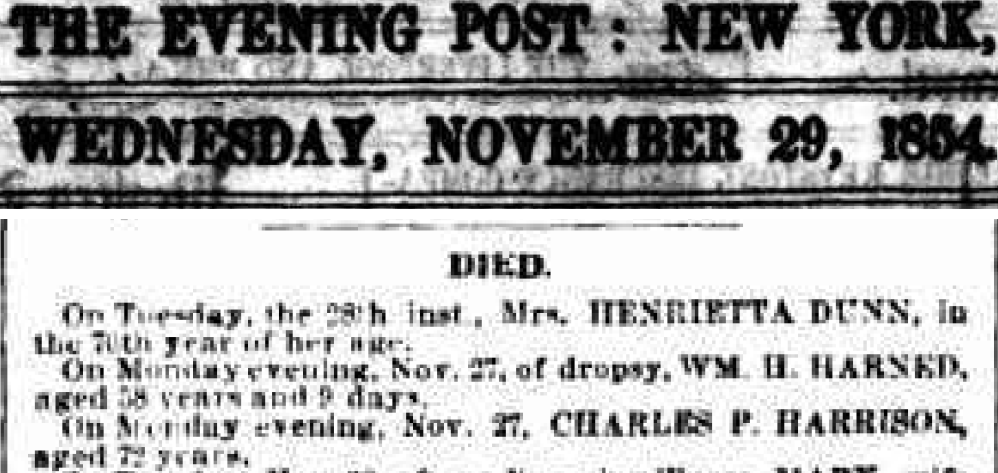Charles Peter Harrison was the son of Elizabeth (nee Foster) and William Harrison, who had married on the 28th of Janurary 1772 at Allhallows, London Wall, London, England.
Source: England Marriages, 1538–1973
Charles came to America with his parents in 1794 where the large family settled in Philadelphia. Charles and several brothers learned the art of engraving and copper-plate printing from their father, who had initially worked for the Bank of North America upon arrival in America.
Elizabeth, his mother, was the daughter of Elmes Foster who died on August 16th 1798: "At the house of his son-in-law, Thomas Squire, esq., at Islip, co. Northampton (England), in his 74th year, Elmes Foster, esq. Late of Great James-str. Bedford-row, and formerly (in consequence of his marriage with a grand-daughter of Mrs Salmon) owner of the wax-work in Fleet-street, which he disposed of, several years ago, to the present proprietors."
Source: Gentleman's Magazine Band 84, page 812, Sep. 1798
While in Philadelphia, Charles printed the First Actual Survey of the State of North Carolina by Price and Strother in 1808.
Source: Price, Jonathan, -1822, et al. To David Stone and Peter Brown, Esq.: this first actual survey of the state of North Carolina taken by the subscribers is respectfully dedicated. Philadelphia: Printed by C.P. Harrison, 1808. Map. Retrieved from the Library of Congress, .
The New-York Historical Society Library, Department of Prints, Photographs, and Architectural Collections had at one time an engraving in its collection done by Charles in 1809 of the 4th U.S. President, James Madison. The former source (https://www.nyhistory.org/web/crossroads/gallery/portraits_and_busts/james_madison_by_edwin.html) is no longer available.
On the 7th of February 1813 Charles P. Harrison wrote to James Madison expressing his hopes that the nation would not forget its seamen's widows and orphans. He enclosed a pamphlet of subscription addresses for 'The American Tar'.
Source: "To James Madison from Charles P. Harrison, 7 February 1813 (Abstract),"Founders Online,National Archives, https://founders.archives.gov/documents/Madison/03-05-02-0557. [Original source:The Papers of James Madison, Presidential Series, vol. 5,10 July 1812–7 February 1813, ed. J. C. A. Stagg, Martha J. King, Ellen J. Barber, Anne Mandeville Colony, Angela Kreider, and Jewel L. Spangler. Charlottesville: University of Virginia Press, 2004, p. 657.]
In 1811 Charles printed William Strickland's map of Philadelphia and in 1823 Thomas Poppleton's Map of Baltimore.
Charles' moved his printing business and his own family from Philadelphia to New York around 1822, at some point thereafter to 3 Reade Street near Broadway and the residence of Aaron Burr.
If size be any indication of family life in the '6th' or 'Fourteenth Ward', 16 and 27 persons were recorded respectively in the 1830 and 1840 U.S. Censuses as living under Mr. Harrison's roof. In 1840, eight of the residents were under 5 years old!
Following the coronation of Queen Victoria in 1838, Charles engraved a portrait of her on copper plate no bigger than a sixpence, that was surrounded by the Lord's Prayer as tiny as a hair line.
Source: The Brooklyn Daily Eagle, 2 Aug. 1891, page 12
Gabriel describes his father, Charles Harrison, in an interview in the Dramatic Mirror of 27 Feb. 1897 as follows: "I Inherited my fondness for the drama from my father, who was an artist and engineer, and was so strongly inclined toward the theatre that he had all the prominent actors at our house as guests. In 1822 we moved to New York, taking a house in Greenwich Street, near the Battery, which was then the aristocratic quarter of the town."
On July 5th, 1942, the New York Times reported that Lafayette College received an anonymous donation in Easton, Pennsylvania. Among many items was a portrait of Lafayette painted by Charles P. Harrison. A signed document from George Washington was also included in the collection. This document may well have been a family heirloom from Charles' father-in-law, James Porter, who was a soldier under Washington and Lafayette.
Additional information about the family can be found under:
Harrison, William J., 1904- Some descendants of William Harrison, engraver, born London, England circa 1750, died Philadelphia, Pa., 1803. Compiled by William J. Harrison.Bloomfield, N.J., 1972. (https://lccn.loc.gov/73170631) i, 54 l. 29 cm. CS71.H32 1972c
https://books.google.de/books?id=Ls4BKE8uHC8C&pg=PA112&lpg=PA112&dq=william+harrison+engraver+philadelphia&source=bl&ots=KUHed6PPbA&sig=ACfU3U23q95KfjGbKCTtG_RWLDLUQl-1lQ&hl=en&sa=X&ved=2ahUKEwityLzoiYL3AhXR66QKHWDwDMMQ6AF6BAgKEAM#v=onepage&q=william%20harrison%20engraver%20philadelphia&f=false
https://archive.org/stream/essayproofjourna03n4essa/essayproofjourna03n4essa_djvu.txt
Biographical entries about Charles' son, Gabriel: The National Cyclopaedia of American Biography Volume 5, 1894, page 218. New York: James T White & Company https://archive.org/stream/nationalcyclopae05newy#page/218/mode/2up
Descendants of Richard Granville Harrison, youngest brother of Charles, can be found at Memorial# 116868186.
PATERNAL ANCESTRY
Charles Peter Harrison was the son of the engraver William Harrison of Philadelphia who came to America in 1794 from London to engrave some of the country's first banknotes. William Harrison died October 18th, 1803 in Philadelphia.
This William was said to have been a descendant of John „Longitude" Harrison who had been married first to Elizabeth Barrel for 8 years and second to Elizabeth Scott who died aged 72. Note: Births were not always recorded and wills might only have included those living or those with whom the deceased was on good terms. Sometimes the oldest son inherited the farm or family business while younger sons sought their fortunes elsewhere.
William, father of Charles and engraver and immigrant to Philadelphia, was said to have been the son of William Harrison, b. May 20th 1728 and d. April 24th 1815. William, father of the Philadelphia engraver, had 3 wives: Elizabeth Atkinson (m. 1761), Susannah Hodgson (m. 1762) and Elizabeth Overton (m. April 24th 1786).
Facts About William Harrison of Philadelphia (d. 1803)
In a doctorate thesis entitled ALEXANDER DALRYMPLE (1737-1808), HYDROGRAPHER TO THE EAST INDIA COMPANY AND TO THE ADMIRALTY AS PUBLISHER. A CATALOGUE OF BOOKS AND CHARTS VOLUME I submitted by Andrew S. Cook to The University of St. Andrews (see https://core.ac.uk/download/8763936.pdf), William Harrison of Philadelphia is mentioned fifteen times beginning on page 160 of the document.
Harrison appears to have begun engraving for Dalrymple around 1779 (p. 224) and became his chief engraver in the 1780s with his main responsibility being the production of charts and plans (pp. 225 and 231). Although Harrison's commissions from Dalrymple constituted his main source of income, he maintained his own engraving business throughout the period leading up to his departure for Philadelphia (p. 231).
On page 232 a brother David of Dalrymple is mentioned, perhaps of interest due to a large inheritance left to William's offspring in 1868. An article on p. 3 of the Philadelphia Enquirer from 28 May 1868 mentions the estate as belonging to William's brother, David, who had made a fortune with the East India Company. In the New York Evening Post from 25 May 1868 however, the deceased uncle was said to be William's brother, Benjamin. This article also claimed both Benjamin and William were the sons of William Harrison, from whom Benjamin initially inherited the estate. Benjamin is said to have increased its value with the East India Company.
William Harrison's name appeared more than any other on Dalrymple's plans and charts between 1780 and 1793 (p.235). In the above mentioned article in the Enquirer, Harrison was then called by the U.S. government to superintend the engraving of the notes of the Bank of North America.
The U.S. Library of Congress has interesting documents regarding Longitude's chronometer which may or may not have been donated by the Harrison engravers of Philadelphia:
- Harrison, John, Nevil Maskelyne, and Great Britain. Commissioners Of Longitude.The principles of Mr. Harrison's time-keeper; with plates of the same. London, Printed by W. Richardson and S. Clark and sold by J. Nourse, 1767. Pdf. Retrieved from the Library of Congress, .
- Harrison, John. Details of a chronometer designed by John Harrison. Photograph. Retrieved from the Library of Congress, .
- Harrison, John. A Description Concerning Such Mechanism as Will Afford a Nice, or True Mensuration of Time: Together With Some Account of the Attempts for the Discovery of the Longitude by the Moon: As Also an Account of the Discovery of the Scale of Musick. London: Printed for the author, 1775. Image. Retrieved from the Library of Congress, .
The certificate of marriage for William Harrison and Elizabeth Foster at All Hallows on 28 January 1772 could shed necessary light on the true identity of William's parents.
Charles Peter Harrison was the son of Elizabeth (nee Foster) and William Harrison, who had married on the 28th of Janurary 1772 at Allhallows, London Wall, London, England.
Source: England Marriages, 1538–1973
Charles came to America with his parents in 1794 where the large family settled in Philadelphia. Charles and several brothers learned the art of engraving and copper-plate printing from their father, who had initially worked for the Bank of North America upon arrival in America.
Elizabeth, his mother, was the daughter of Elmes Foster who died on August 16th 1798: "At the house of his son-in-law, Thomas Squire, esq., at Islip, co. Northampton (England), in his 74th year, Elmes Foster, esq. Late of Great James-str. Bedford-row, and formerly (in consequence of his marriage with a grand-daughter of Mrs Salmon) owner of the wax-work in Fleet-street, which he disposed of, several years ago, to the present proprietors."
Source: Gentleman's Magazine Band 84, page 812, Sep. 1798
While in Philadelphia, Charles printed the First Actual Survey of the State of North Carolina by Price and Strother in 1808.
Source: Price, Jonathan, -1822, et al. To David Stone and Peter Brown, Esq.: this first actual survey of the state of North Carolina taken by the subscribers is respectfully dedicated. Philadelphia: Printed by C.P. Harrison, 1808. Map. Retrieved from the Library of Congress, .
The New-York Historical Society Library, Department of Prints, Photographs, and Architectural Collections had at one time an engraving in its collection done by Charles in 1809 of the 4th U.S. President, James Madison. The former source (https://www.nyhistory.org/web/crossroads/gallery/portraits_and_busts/james_madison_by_edwin.html) is no longer available.
On the 7th of February 1813 Charles P. Harrison wrote to James Madison expressing his hopes that the nation would not forget its seamen's widows and orphans. He enclosed a pamphlet of subscription addresses for 'The American Tar'.
Source: "To James Madison from Charles P. Harrison, 7 February 1813 (Abstract),"Founders Online,National Archives, https://founders.archives.gov/documents/Madison/03-05-02-0557. [Original source:The Papers of James Madison, Presidential Series, vol. 5,10 July 1812–7 February 1813, ed. J. C. A. Stagg, Martha J. King, Ellen J. Barber, Anne Mandeville Colony, Angela Kreider, and Jewel L. Spangler. Charlottesville: University of Virginia Press, 2004, p. 657.]
In 1811 Charles printed William Strickland's map of Philadelphia and in 1823 Thomas Poppleton's Map of Baltimore.
Charles' moved his printing business and his own family from Philadelphia to New York around 1822, at some point thereafter to 3 Reade Street near Broadway and the residence of Aaron Burr.
If size be any indication of family life in the '6th' or 'Fourteenth Ward', 16 and 27 persons were recorded respectively in the 1830 and 1840 U.S. Censuses as living under Mr. Harrison's roof. In 1840, eight of the residents were under 5 years old!
Following the coronation of Queen Victoria in 1838, Charles engraved a portrait of her on copper plate no bigger than a sixpence, that was surrounded by the Lord's Prayer as tiny as a hair line.
Source: The Brooklyn Daily Eagle, 2 Aug. 1891, page 12
Gabriel describes his father, Charles Harrison, in an interview in the Dramatic Mirror of 27 Feb. 1897 as follows: "I Inherited my fondness for the drama from my father, who was an artist and engineer, and was so strongly inclined toward the theatre that he had all the prominent actors at our house as guests. In 1822 we moved to New York, taking a house in Greenwich Street, near the Battery, which was then the aristocratic quarter of the town."
On July 5th, 1942, the New York Times reported that Lafayette College received an anonymous donation in Easton, Pennsylvania. Among many items was a portrait of Lafayette painted by Charles P. Harrison. A signed document from George Washington was also included in the collection. This document may well have been a family heirloom from Charles' father-in-law, James Porter, who was a soldier under Washington and Lafayette.
Additional information about the family can be found under:
Harrison, William J., 1904- Some descendants of William Harrison, engraver, born London, England circa 1750, died Philadelphia, Pa., 1803. Compiled by William J. Harrison.Bloomfield, N.J., 1972. (https://lccn.loc.gov/73170631) i, 54 l. 29 cm. CS71.H32 1972c
https://books.google.de/books?id=Ls4BKE8uHC8C&pg=PA112&lpg=PA112&dq=william+harrison+engraver+philadelphia&source=bl&ots=KUHed6PPbA&sig=ACfU3U23q95KfjGbKCTtG_RWLDLUQl-1lQ&hl=en&sa=X&ved=2ahUKEwityLzoiYL3AhXR66QKHWDwDMMQ6AF6BAgKEAM#v=onepage&q=william%20harrison%20engraver%20philadelphia&f=false
https://archive.org/stream/essayproofjourna03n4essa/essayproofjourna03n4essa_djvu.txt
Biographical entries about Charles' son, Gabriel: The National Cyclopaedia of American Biography Volume 5, 1894, page 218. New York: James T White & Company https://archive.org/stream/nationalcyclopae05newy#page/218/mode/2up
Descendants of Richard Granville Harrison, youngest brother of Charles, can be found at Memorial# 116868186.
PATERNAL ANCESTRY
Charles Peter Harrison was the son of the engraver William Harrison of Philadelphia who came to America in 1794 from London to engrave some of the country's first banknotes. William Harrison died October 18th, 1803 in Philadelphia.
This William was said to have been a descendant of John „Longitude" Harrison who had been married first to Elizabeth Barrel for 8 years and second to Elizabeth Scott who died aged 72. Note: Births were not always recorded and wills might only have included those living or those with whom the deceased was on good terms. Sometimes the oldest son inherited the farm or family business while younger sons sought their fortunes elsewhere.
William, father of Charles and engraver and immigrant to Philadelphia, was said to have been the son of William Harrison, b. May 20th 1728 and d. April 24th 1815. William, father of the Philadelphia engraver, had 3 wives: Elizabeth Atkinson (m. 1761), Susannah Hodgson (m. 1762) and Elizabeth Overton (m. April 24th 1786).
Facts About William Harrison of Philadelphia (d. 1803)
In a doctorate thesis entitled ALEXANDER DALRYMPLE (1737-1808), HYDROGRAPHER TO THE EAST INDIA COMPANY AND TO THE ADMIRALTY AS PUBLISHER. A CATALOGUE OF BOOKS AND CHARTS VOLUME I submitted by Andrew S. Cook to The University of St. Andrews (see https://core.ac.uk/download/8763936.pdf), William Harrison of Philadelphia is mentioned fifteen times beginning on page 160 of the document.
Harrison appears to have begun engraving for Dalrymple around 1779 (p. 224) and became his chief engraver in the 1780s with his main responsibility being the production of charts and plans (pp. 225 and 231). Although Harrison's commissions from Dalrymple constituted his main source of income, he maintained his own engraving business throughout the period leading up to his departure for Philadelphia (p. 231).
On page 232 a brother David of Dalrymple is mentioned, perhaps of interest due to a large inheritance left to William's offspring in 1868. An article on p. 3 of the Philadelphia Enquirer from 28 May 1868 mentions the estate as belonging to William's brother, David, who had made a fortune with the East India Company. In the New York Evening Post from 25 May 1868 however, the deceased uncle was said to be William's brother, Benjamin. This article also claimed both Benjamin and William were the sons of William Harrison, from whom Benjamin initially inherited the estate. Benjamin is said to have increased its value with the East India Company.
William Harrison's name appeared more than any other on Dalrymple's plans and charts between 1780 and 1793 (p.235). In the above mentioned article in the Enquirer, Harrison was then called by the U.S. government to superintend the engraving of the notes of the Bank of North America.
The U.S. Library of Congress has interesting documents regarding Longitude's chronometer which may or may not have been donated by the Harrison engravers of Philadelphia:
- Harrison, John, Nevil Maskelyne, and Great Britain. Commissioners Of Longitude.The principles of Mr. Harrison's time-keeper; with plates of the same. London, Printed by W. Richardson and S. Clark and sold by J. Nourse, 1767. Pdf. Retrieved from the Library of Congress, .
- Harrison, John. Details of a chronometer designed by John Harrison. Photograph. Retrieved from the Library of Congress, .
- Harrison, John. A Description Concerning Such Mechanism as Will Afford a Nice, or True Mensuration of Time: Together With Some Account of the Attempts for the Discovery of the Longitude by the Moon: As Also an Account of the Discovery of the Scale of Musick. London: Printed for the author, 1775. Image. Retrieved from the Library of Congress, .
The certificate of marriage for William Harrison and Elizabeth Foster at All Hallows on 28 January 1772 could shed necessary light on the true identity of William's parents.
Family Members
-
![]()
Marianne Harrison
1805–1896
-
![]()
Eleanor Catherine Harrison Ackerman
1806–1890
-
![]()
Margaret Cecelia Harrison Hernandez
1810–1887
-
![]()
Frances "Fanny" Harrison
1812–1879
-
![]()
Ann Jane Harrison Jardines
1817–1891
-
![]()
Gabriel Harrison
1818–1902
-
Lafayette Felix Harrison
1824–1892
-
![]()
Cleopha Maria Harrison Smith
1829–1911
-
![]()
Lucretia N. Harrison Morales
unknown–1887
Advertisement
Records on Ancestry
Sponsored by Ancestry
Advertisement














